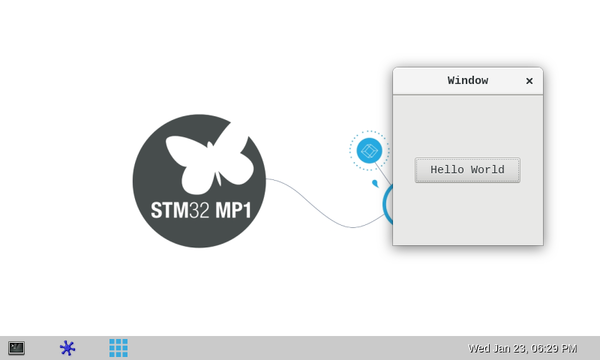This message will disappear after all relevant tasks have been resolved.
Semantic MediaWiki
There are 1 incomplete or pending task to finish installation of Semantic MediaWiki. An administrator or user with sufficient rights can complete it. This should be done before adding new data to avoid inconsistencies.
Overview[edit source]
This stage explains how to create, build and execute a simple C code application using the freshly installed SDK.
Code[edit source]
- Create a directory that will host your source codes
mkdir $HOME/STM32MPU_workspace/STM32MP1-Ecosystem-v5.0.0/Developer-Package/stm32mp1-openstlinux-23.06.21 mkdir $HOME/STM32MPU_workspace/STM32MP1-Ecosystem-v5.0.0/Developer-Package/stm32mp1-openstlinux-23.06.21/sources
- Create a directory for your user space example
mkdir $HOME/STM32MPU_workspace/STM32MP1-Ecosystem-v5.0.0/Developer-Package/stm32mp1-openstlinux-23.06.21/sources/gtk_hello_world_example cd $HOME/STM32MPU_workspace/STM32MP1-Ecosystem-v5.0.0/Developer-Package/stm32mp1-openstlinux-23.06.21/sources/gtk_hello_world_example
- Create the source code file for your user space example: gtk_hello_world.c
#include <gtk/gtk.h>
static void
print_hello (GtkWidget *widget,
gpointer data)
{
g_print ("Hello World\n");
}
static void
activate (GtkApplication *app,
gpointer user_data)
{
GtkWidget *window;
GtkWidget *button;
GtkWidget *button_box;
window = gtk_application_window_new (app);
gtk_window_set_title (GTK_WINDOW (window), "Window");
gtk_window_set_default_size (GTK_WINDOW (window), 200, 200);
button_box = gtk_button_box_new (GTK_ORIENTATION_HORIZONTAL);
gtk_container_add (GTK_CONTAINER (window), button_box);
button = gtk_button_new_with_label ("Hello World");
g_signal_connect (button, "clicked", G_CALLBACK (print_hello), NULL);
g_signal_connect_swapped (button, "clicked", G_CALLBACK (gtk_widget_destroy), window);
gtk_container_add (GTK_CONTAINER (button_box), button);
gtk_widget_show_all (window);
}
int
main (int argc,
char **argv)
{
GtkApplication *app;
int status;
app = gtk_application_new ("org.gtk.example", G_APPLICATION_DEFAULT_FLAGS);
g_signal_connect (app, "activate", G_CALLBACK (activate), NULL);
status = g_application_run (G_APPLICATION (app), argc, argv);
g_object_unref (app);
return status;
}
Build[edit source]
- Create the makefile for your user space example: Makefile
PROG = gtk_hello_world SRCS = gtk_hello_world.c CLEANFILES = $(PROG) # Add / change option in CFLAGS and LDFLAGS CFLAGS += -Wall $(shell pkg-config --cflags gtk+-3.0) LDFLAGS += $(shell pkg-config --libs gtk+-3.0) all: $(PROG) $(PROG): $(SRCS) $(CC) -o $@ $^ $(CFLAGS) $(LDFLAGS) clean: rm -f $(CLEANFILES) $(patsubst %.c,%.o, $(SRCS))
- Cross-compile the project
make
Deploy and execute[edit source]
- Push this binary onto the board (Ethernet connection needed)
scp gtk_hello_world root@<board ip address>:/usr/local
- Execute your user space example by using the user "weston"
cd /usr/local/ su -l weston -c "/usr/local/gtk_hello_world"
- A GTK window is displayed
- Click the "Hello world" button to close the window. Hello world is displayed on the console:
Hello world

